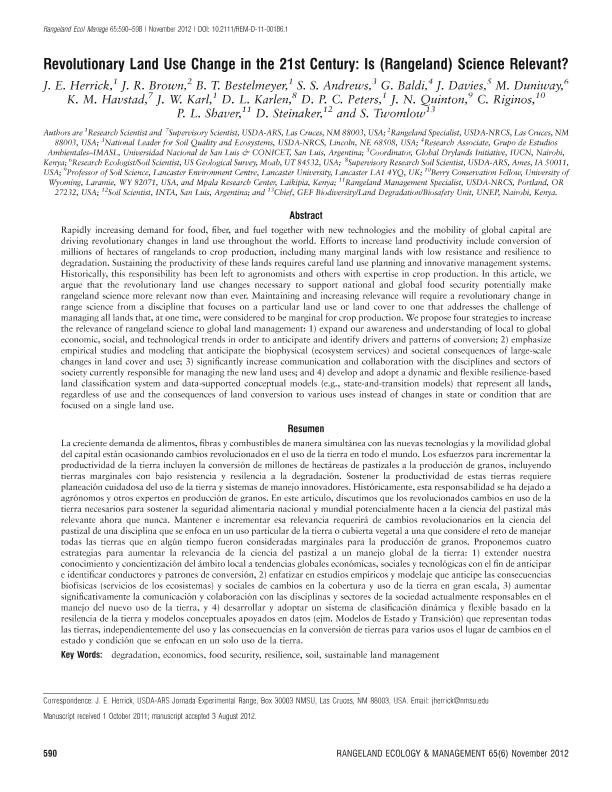Mostrar el registro sencillo del ítem
dc.contributor.author
Herrick, J. E.
dc.contributor.author
Brown, J. R.
dc.contributor.author
Bestelmeyer, B. T.
dc.contributor.author
Andrews, S. S.
dc.contributor.author
Baldi, Germán

dc.contributor.author
Davies, J.
dc.contributor.author
Duniway, M.
dc.contributor.author
Havstad, K. M.
dc.contributor.author
Karl, J. W.
dc.contributor.author
Karlen, D. L.
dc.contributor.author
Peters, D. P. C.
dc.contributor.author
Quinton, J. N.
dc.contributor.author
Riginos, C.
dc.contributor.author
Shaver, P. L.
dc.contributor.author
Steinaker, D.
dc.contributor.author
Twomlow, S.
dc.date.available
2017-02-03T18:18:04Z
dc.date.issued
2012-11
dc.identifier.citation
Herrick, J. E.; Brown, J. R.; Bestelmeyer, B. T.; Andrews, S. S.; Baldi, Germán; et al.; Revolutionary Land Use Change in the 21st Century: Is (Rangeland) Science Relevant?; Society For Range Management; Rangeland Ecology And Management; 65; 6; 11-2012; 590-598
dc.identifier.issn
1550-7424
dc.identifier.uri
http://hdl.handle.net/11336/12445
dc.description.abstract
Rapidly increasing demand for food, fiber, and fuel together with new technologies and the mobility of global capital are driving revolutionary changes in land use throughout the world. Efforts to increase land productivity include conversion of millions of hectares of rangelands to crop production, including many marginal lands with low resistance and resilience to<br />degradation. Sustaining the productivity of these lands requires careful land use planning and innovative management systems. Historically, this responsibility has been left to agronomists and others with expertise in crop production. In this article, we argue that the revolutionary land use changes necessary to support national and global food security potentially make<br />rangeland science more relevant now than ever. Maintaining and increasing relevance will require a revolutionary change in range science from a discipline that focuses on a particular land use or land cover to one that addresses the challenge of managing all lands that, at one time, were considered to be marginal for crop production. We propose four strategies to increase the relevance of rangeland science to global land management: 1) expand our awareness and understanding of local to global economic, social, and technological trends in order to anticipate and identify drivers and patterns of conversion; 2) emphasize empirical studies and modeling that anticipate the biophysical (ecosystem services) and societal consequences of large-scale changes in land cover and use; 3) significantly increase communication and collaboration with the disciplines and sectors of society currently responsible for managing the new land uses; and 4) develop and adopt a dynamic and flexible resilience-based land classification system and data-supported conceptual models (e.g., state-and-transition models) that represent all lands, regardless of use and the consequences of land conversion to various uses instead of changes in state or condition that are focused on a single land use.
dc.format
application/pdf
dc.language.iso
eng
dc.publisher
Society For Range Management

dc.rights
info:eu-repo/semantics/openAccess
dc.rights.uri
https://creativecommons.org/licenses/by-nc-nd/2.5/ar/
dc.subject
Degradation
dc.subject
Economics
dc.subject
Food Security
dc.subject
Resilience
dc.subject
Soil
dc.subject
Sustainable Land Management
dc.subject.classification
Agricultura

dc.subject.classification
Agricultura, Silvicultura y Pesca

dc.subject.classification
CIENCIAS AGRÍCOLAS

dc.title
Revolutionary Land Use Change in the 21st Century: Is (Rangeland) Science Relevant?
dc.type
info:eu-repo/semantics/article
dc.type
info:ar-repo/semantics/artículo
dc.type
info:eu-repo/semantics/publishedVersion
dc.date.updated
2016-11-24T19:23:12Z
dc.journal.volume
65
dc.journal.number
6
dc.journal.pagination
590-598
dc.journal.pais
Estados Unidos

dc.journal.ciudad
Boulder
dc.description.fil
Fil: Herrick, J. E.. United States Department Of Agriculture; Estados Unidos
dc.description.fil
Fil: Brown, J. R.. United States Department Of Agriculture; Estados Unidos
dc.description.fil
Fil: Bestelmeyer, B. T.. United States Department Of Agriculture; Estados Unidos
dc.description.fil
Fil: Andrews, S. S.. United States Department Of Agriculture; Estados Unidos
dc.description.fil
Fil: Baldi, Germán. Consejo Nacional de Investigaciones Científicas y Técnicas. Centro Científico Tecnológico San Luis. Instituto de Matemática Aplicada de San Luis; Argentina
dc.description.fil
Fil: Davies, J.. International Union for Conservation of Nature; Kenia
dc.description.fil
Fil: Duniway, M.. US Geological Survey; Estados Unidos
dc.description.fil
Fil: Havstad, K. M.. United States Department Of Agriculture; Estados Unidos
dc.description.fil
Fil: Karl, J. W.. United States Department Of Agriculture; Estados Unidos
dc.description.fil
Fil: Karlen, D. L.. United States Department Of Agriculture; Estados Unidos
dc.description.fil
Fil: Peters, D. P. C.. United States Department Of Agriculture; Estados Unidos
dc.description.fil
Fil: Quinton, J. N.. Lancaster University; Reino Unido
dc.description.fil
Fil: Riginos, C.. University of Wyoming; Estados Unidos
dc.description.fil
Fil: Shaver, P. L.. United States Department Of Agriculture; Estados Unidos
dc.description.fil
Fil: Steinaker, D.. Instituto Nacional de Tecnología Agropecuaria; Argentina
dc.description.fil
Fil: Twomlow, S.. United Nations Environment Programme; Kenia
dc.journal.title
Rangeland Ecology And Management

dc.relation.alternativeid
info:eu-repo/semantics/altIdentifier/url/http://www.sciencedirect.com/science/article/pii/S1550742412500977
dc.relation.alternativeid
info:eu-repo/semantics/altIdentifier/doi/http://dx.doi.org/10.2111/REM-D-11-00186.1
dc.relation.alternativeid
info:eu-repo/semantics/altIdentifier/url/http://www.bioone.org/doi/abs/10.2111/REM-D-11-00186.1
Archivos asociados
